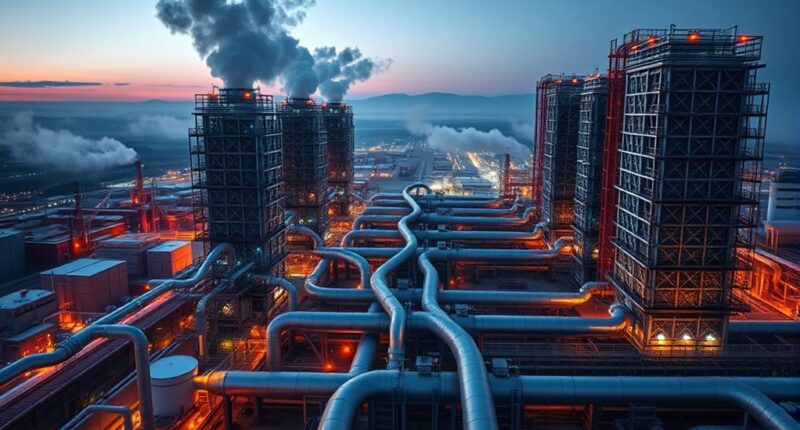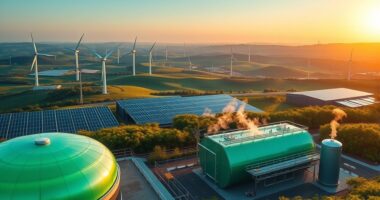Carbon capture plants can help reduce industrial emissions and fight climate change, but large-scale air cleaning faces hurdles. They are often energy-intensive and costly, making widespread adoption difficult without technological advances and supportive policies. Environmental concerns like land use and resource consumption also matter. If they overcome these challenges, their potential for significant emission reductions increases. Want to discover how ongoing innovations are shaping their future and whether they can truly clean the air at scale?
Key Takeaways
- Carbon capture plants can significantly reduce industrial CO₂ emissions but face challenges in scaling due to high costs and energy demands.
- Technological advancements are improving efficiency, making large-scale deployment more feasible in the future.
- Environmental risks, such as land use and CO₂ storage safety, require careful management and monitoring.
- Widespread adoption depends on supportive policies, investments, and integration with existing infrastructure.
- While promising, current limitations mean they cannot fully clean the air at scale without further innovation and support.

As concerns about climate change grow, carbon capture plants have become an essential tool in reducing greenhouse gas emissions. These facilities aim to trap carbon dioxide directly from industrial sources or the atmosphere, helping to lower the overall carbon footprint. However, understanding whether they can be deployed at scale requires examining their industrial feasibility and environmental impact. You might wonder if large-scale implementation is practical and if it genuinely benefits the environment, or if it introduces new challenges.
When considering industrial feasibility, you need to evaluate how well carbon capture plants integrate into existing infrastructure. Currently, many capture systems are energy-intensive and costly to operate, which raises questions about their economic viability. Large industries like cement, steel, and chemical manufacturing already face tight profit margins, so adopting such technology demands significant investment and operational adjustments. While ongoing technological advances are reducing costs and improving efficiency, scaling these plants to cover entire industries remains a complex task. You should recognize that building enough capture capacity to make a meaningful impact involves not just technological readiness but also logistical and financial considerations. Governments, private investors, and industries must collaborate to develop supportive policies and funding mechanisms to make large-scale deployment feasible. Additionally, the integration of vertical storage solutions can enhance the effectiveness of carbon capture efforts.
Scaling carbon capture requires technological, logistical, and financial solutions for industry-wide impact.
Environmental impact is another critical factor to weigh. Carbon capture plants are designed to reduce emissions, but they also come with potential environmental trade-offs. The construction and operation of these facilities can lead to land use changes, energy consumption, and resource use that might offset some benefits if not managed properly. For example, if a capture plant consumes a significant amount of electricity generated from fossil fuels, the net reduction in greenhouse gases could be less than expected. Additionally, the disposal or utilization of captured CO₂, such as storage underground, carries risks like leakage or induced seismic activity. You need to consider whether the environmental benefits outweigh these potential drawbacks. Proper site selection, safety measures, and ongoing monitoring are essential to ensure that the environmental impact remains positive.
Ultimately, while carbon capture plants hold promise, their success at scale hinges on addressing these challenges. You should remain aware that technological innovation, economic support, and thorough environmental assessments are vital to making these plants a practical, widespread solution. They could play a significant role in reducing atmospheric CO₂ levels, but only if their industrial feasibility improves and their environmental impacts are carefully managed. By approaching their deployment thoughtfully, you can help ensure that carbon capture becomes a powerful tool in the fight against climate change.
Frequently Asked Questions
What Are the Long-Term Environmental Impacts of Carbon Capture Plants?
You might wonder about the long-term impacts of carbon capture plants. They could cause ecosystem disruption if not properly managed, affecting local wildlife and plant life. Also, resource depletion is a concern, as these plants require significant energy and materials. While they aim to reduce emissions, you should consider whether their benefits outweigh potential environmental costs over time, especially regarding sustainability and ecological balance.
How Much Do Carbon Capture Technologies Cost to Implement Globally?
You wonder about the cost of implementing carbon capture technologies worldwide. While the economic feasibility varies, advancements in technology are gradually lowering expenses. Today, capturing a ton of CO₂ can range from $50 to over $100, depending on the method and location. As technological innovations continue, expect costs to decrease further, making large-scale deployment more attainable and cost-effective in the future.
Are There Any Health Risks Associated With Carbon Capture Operations?
You should know that there are health risks linked to carbon capture operations, especially concerning worker safety. Workers might be exposed to chemicals used in the process, which can cause respiratory issues or skin irritation if proper safety measures aren’t in place. It’s vital that operators follow strict protocols to minimize chemical exposure, ensuring a safe environment and reducing potential health hazards during plant operation.
Can Carbon Capture Plants Be Integrated With Renewable Energy Sources?
Think of carbon capture plants as dancers, perfectly synchronized with renewable energy sources. You can integrate them through renewable integration, allowing clean energy like wind or solar to power capture processes. This synergy boosts emission reduction efforts, making the system more efficient and sustainable. By combining these technologies, you help turn the tide against climate change, ensuring cleaner air and a healthier planet for everyone.
What Policies Are Needed to Promote Widespread Adoption of Carbon Capture?
To promote widespread adoption of carbon capture, you need policies like implementing a strong carbon tax that incentivizes reduction efforts. Subsidy programs can help offset costs for companies investing in these technologies. By making carbon capture financially attractive and easier to adopt, these policies encourage industry commitment, accelerate innovation, and guarantee cleaner air at scale. Your support and advocacy for such policies are essential to advancing this critical technology.
Conclusion
So, as you consider the promise of carbon capture plants, ask yourself: are they truly the heroes we need to combat climate change? They hold hope like a flickering flame in the dark, but rely on us to fuel their potential. While they can make a difference, it’s up to us to reduce emissions and embrace sustainable choices. Together, we can turn this fragile spark into a blazing future for our planet.










